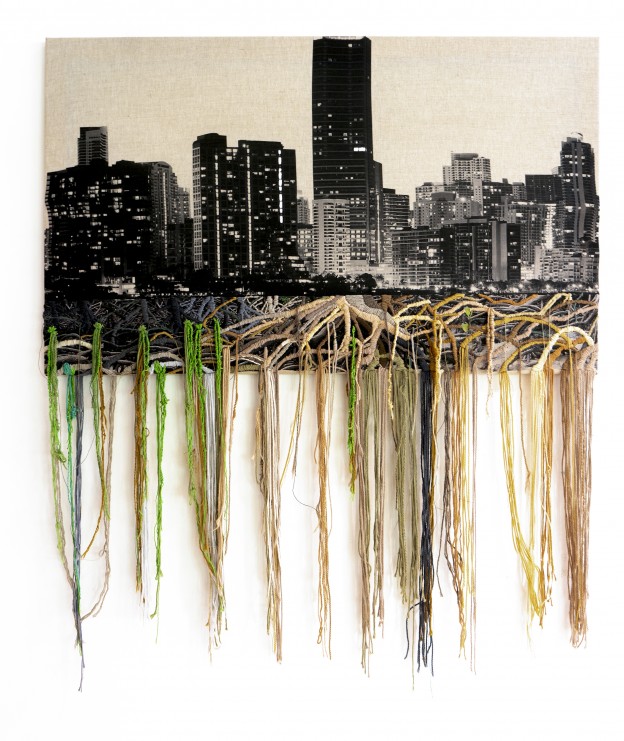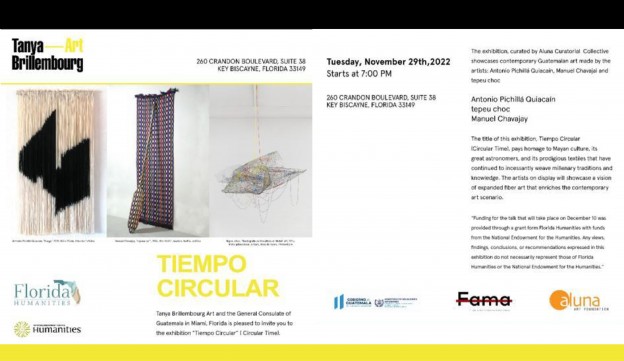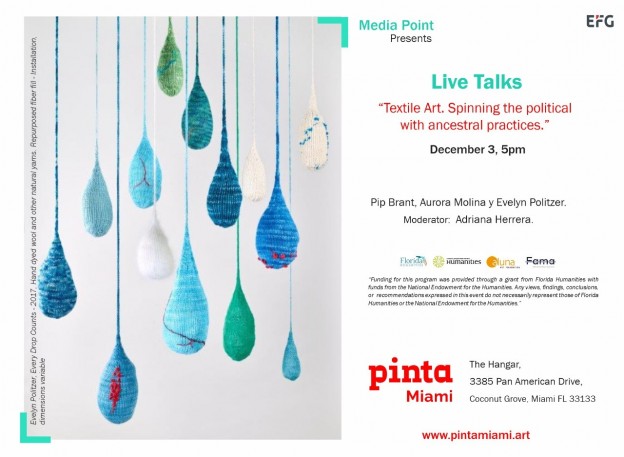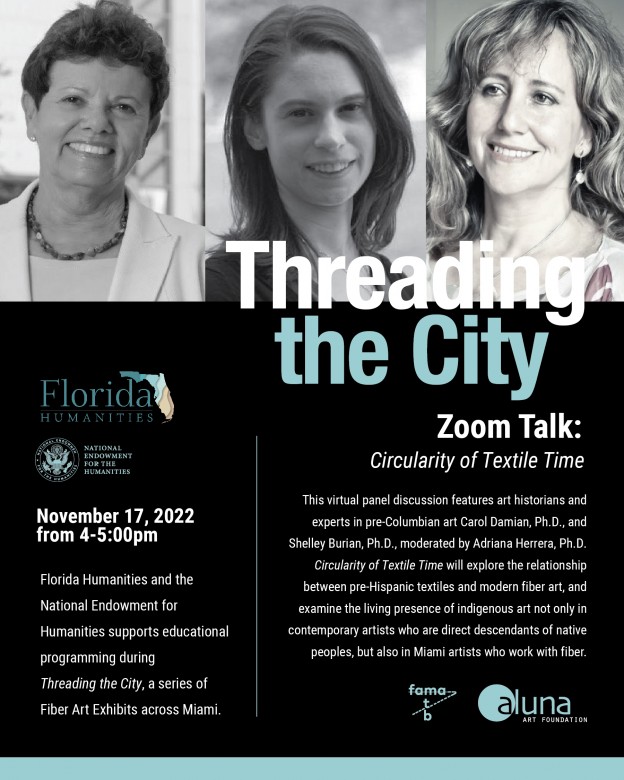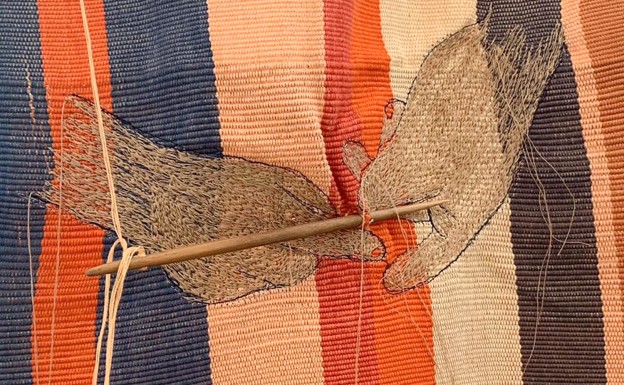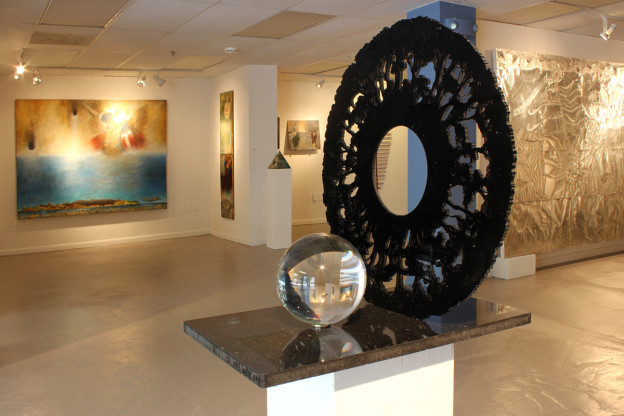
Concerning The Spiritual in Art. Aluna Art Foundation. Arte al Dia, 01.21.2013
by Deborah Castellanos
“Concerning the Spiritual in Art”, Aluna Art Foundation’s inaugural exhibit for this alternative curatorial space that opened its doors in August, showcased a collection of works by a group of artists both renowned and unrepresented within the Miami art scene, that reflect their search for “the spiritual in art”.
Kandinsky had written in his book of 1911 about a new abstract language born of the genuine inner necessity of artists for spirituality and freedom, considering that artists should be “deaf to the transitory teaching and demands of (their) particular age” and that art had to be born from within. This spiritual quest initiated in modernism is recaptured a century later here, in the midst of contemporaneity, where after the end of utopias, the search for spirituality becomes once again one of the driving forces behind artistic creation.
Aluna’s curatorial collective, composed of art historian Willy Castellanos and art critic Adriana Herrera, have put together an exhilarating collection of eleven artists working in diverse media, all embarked upon the same dialogue with the spiritual and the mystical – yet in their own unique way. The splendid variety of media excites the visual senses by conveying in different languages the materialization of the invisible relation with spirituality, while generating new interesting dialectics within contemporary art.
The central space of the gallery features a group show by the Colombians Jorge Cavalier and Sara Modiano (1951-2010), the Argentinean Nicolás Leiva, the Venezuelans Andrés Michelena, Evelyn Valdirio and Lili(ana) González, and the Cubans Heriberto Mora and Raimundo Travieso.
Upon entering the exhibit, visitors discover Cavalier’s striking installations: a mix of large canvases and a series of curved laser-cut labyrinth and circular aluminum sculptures that deal with the imagery of the forest as a medium for spiritual regeneration and cyclical renewal of the soul. Equally large is Leiva’s experimental, artisanal, carved diptych mural − initially in metal over a wooden base, it becomes part of the final piece that contains traces of the process of creation, symbolically named after Proverbs from the Bible. Also executed in metal is Modiano’s abstract cubic wire mesh installation Ser 4 of 2002, which creates a three dimensional space that perpetually extends into infinity through the reflection of the cubes into the mirrors in its base.
Lili(Ana)’s bright Anotaciones de lo Invisible (2007/2010) also depict in a three dimensional manner the ephemerality of life and the powerful experience of spirituality. Similarly powerful, but dark, are Michelena’s exploration of the cosmic Buddhist void. The black paintings and the acrylic sculpture of Buddha Empty Nest (2008)evoke the emptiness, openness, interconnectedness and impermanence of all things, immersing the spectator in a deep reflective trance. Valdirio’s angel depictions are equally impressive: her canvases fill the room with powerful visions of angels surrounding the dark paths of human masses in history. They are a cry for protection and spiritual guidance.
The performance of American artist Billie Grace Lynn − part of her ongoing Mad Cow project − was among the highlights of the show. Dealing with themes of slaughterhouse cruelty and environmental degradation, it started with a ceremonial walk of a calf’s skeleton held on strings by visitors –almost animated by a collective spiritual breath, immediately after which she sat on a milking stool and invited spectators to take turns in cutting her hair. An act of desperation, loss, fear, pain and self-mutilation, Lynn’s performance connected her spiritually to the souls of these animals and in a wider sense, to the suffering of the Earth as it cries out for help. The exhibition induces a strange reverence towards not only the spiritual represented through these pieces, but towards man himself.
ACERCA DE LO ESPIRITUAL EN EL ARTE
Aluna Art Foundation, Miami
por Deborah Castellanos
“Concerning the Spiritual in Art”, la exhibición inaugural de Aluna Art Foundation, espacio curatorial alternativo que abrió sus puertas en agosto, mostró una colección de trabajos tanto de artistas reconocidos como sin representación pertenecientes a la escena artística de Miami, que reflejan la búsqueda “de lo espiritual en el arte”.
Kandinsky escribió en su famoso libro de 1911 acerca de un nuevo lenguaje abstracto nacido de la genuina necesidad interior de libertad y espiritualidad, considerando que el arte debe “desoír las demandas de una época” y surgir desde dentro. Esta búsqueda espiritual reiniciada de este modo en el modernismo se reactualiza un siglo después, en medio de la contemporaneidad, donde tras el fin de las utopías, vuelve a ser una de las fuerzas motrices de la creación artística.
El historiador de arte Willy Castellanos y la crítica de arte Adriana Herrera, de Aluna Curatorial Collective, han reunido una inspiradora colección de once artistas que trabajan en medios diversos, abordando el mismo diálogo con lo espiritual y lo místico, cada uno a su propio modo. La espléndida variedad de medios excita los sentidos visuales, abarcando en diferentes lenguajes la materialización de la relación con lo espiritual y generando interesantes dialécticas dentro del arte contemporáneo.
El espacio central de la galería muestra un grupo de obras de los colombianos Jorge Cavalier y Sara Modiano (1951-2010), del argentino Nicolás Leiva, de los venezolanos Andrés Michelena, Evelyn Valdirio y Lili(ana) González, y de los cubanos Heriberto Mora y Raimundo Travieso.
Cautivando al visitante desde la entrada están las instalaciones de Cavalier: una combinación de grandes pinturas con una serie de esculturas laberínticas y circulares de aluminio, curvadas y cortadas a láser, que trabajan con la imaginería del bosque como un medio para la regeneración espiritual y la renovación cíclica del alma. Igualmente de grandes dimensiones es el experimental díptico mural de base artesanal tallado por Leiva –inicialmente en metal sobre una base de madera − que se volvió parte de la pieza final, como un trabajo que contiene el proceso de creación. La pieza tiene el nombre de un proverbio bíblico. También está trabajada en metal la instalación con cubos de malla de alambre Ser 4, 2002, que crea un espacio tridimensional que se extiende hacia lo infinito por la reflexión de los espejos en su base.
Las luminosas Anotaciones de lo Invisible (2007/2010) de Lili(ana) también representan en una forma tridimensional lo efímero de la vida y la poderosa experiencia de lo espiritual. Similarmente poderosa, pero oscura es las exploración del vacío budista cósmico, la obra de Cavalier. Las pinturas negras y la escultura del Buda Empty Nest (2008)evocan la vacuidad, la apertura, la interconectividad y la no permanencia de todas las cosas, sumergiendo al espectador en un profundo trance reflexivo. Las representaciones de ángeles de Valdirio no son menos impresionantes: sus lienzos se apoderan del cubo blanco con visiones de ángeles que rodean los senderos de las masas humanas en la historia y lo llenan con su clamor por protección y guía espiritual.
La performance de la artista americana Billie Grace Lynn –parte de su proyecto en construcción Mad Cow- estuvo entre los más destacados de la exhibición. Lidiando con el tema de la crueldad de los mataderos y la degradación ambiental, comenzó con una caminata ceremonial de un esqueleto de ternero que los visitantes sostenían con cuerdas –casi animándolo con su respiración colectiva − e inmediatamente después la artista se sentó en una silla de ordeñar e invitó a los espectadores a cortarle el cabello completamente. Un acto de desesperación, pérdida, miedo y mutilación auto-permitida, la performance de Lynn la conectó espiritualmente con las almas de los animales y en un horizonte más amplio, con el sufrimiento de la tierra que clama por auxilio. La exhibición introduce una extraña reverencia no solo en torno a lo espiritual representado en esas piezas, sino al ser humano mismo.



